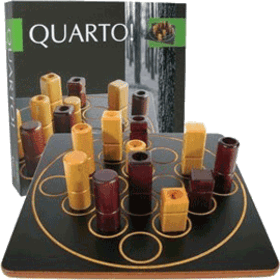quarto
 Quarto has a 4×4 board and 16 pieces. Each piece has four dichotomous attributes — color, height, shape, and consistency — so each piece is either black or white, tall or short, square or round, and hollow or solid. The object is to place the fourth piece in a row in which all four pieces have at least one attribute in common. The twist is that your opponent gets to choose the piece you place on the board each turn.
Quarto has a 4×4 board and 16 pieces. Each piece has four dichotomous attributes — color, height, shape, and consistency — so each piece is either black or white, tall or short, square or round, and hollow or solid. The object is to place the fourth piece in a row in which all four pieces have at least one attribute in common. The twist is that your opponent gets to choose the piece you place on the board each turn.
LB_NUMBER_OF_PLAYERS: 2
Game duration: 4 mn
Complexity: 1 / 5
Play quarto and 1194 other games online.
No download, directly from your web browser.
With your friends and thousands of players from the whole world.
Free.

Play quarto and 1194 other games online.
No download, directly from your web browser.
With your friends and thousands of players from the whole world.
Free.

Rules summary
Quarto is an abstract board game for 2 players. Players compete to place pieces on a 4x4 grid, to be the first player to make a line of four pieces (or in advanced variant, also a 2x2 square) where all of them share some characteristic. The twist is that the opponent chooses the piece to be played.
Start of the game
The board is divided into 16 spaces in a 4x4 grid. There are 16 pieces. Each piece can be light or dark, tall or short, circular or square, and solid or hollow. Each possible combination (for example, light/tall/circular/solid or dark/short/square/hollow) appears exactly once. The board starts off empty; all pieces are off the board.
Player's turn
In a player's turn, two steps happen. First, the opponent chooses a piece, then the player chooses a space to place the piece. Any piece still off the board may be selected, and any empty space may be selected.
End of the game
The game ends when there is a line of four occupied spaces, of which all four pieces in the line share a common trait (for example, all light or all short). The player that places the last piece that forms that line of four (not the opponent who selected it) is the winner.
In the advanced variant, a 2x2 area that share a common trait also ends the game, winning for the player that places the piece.

